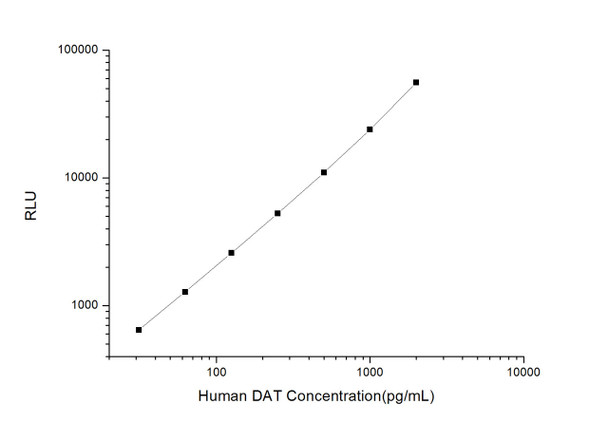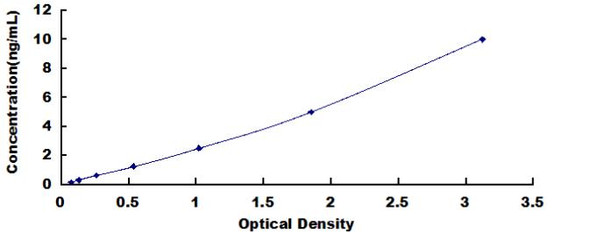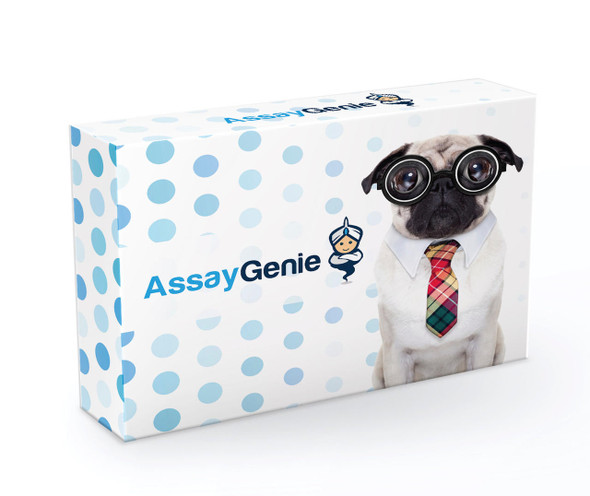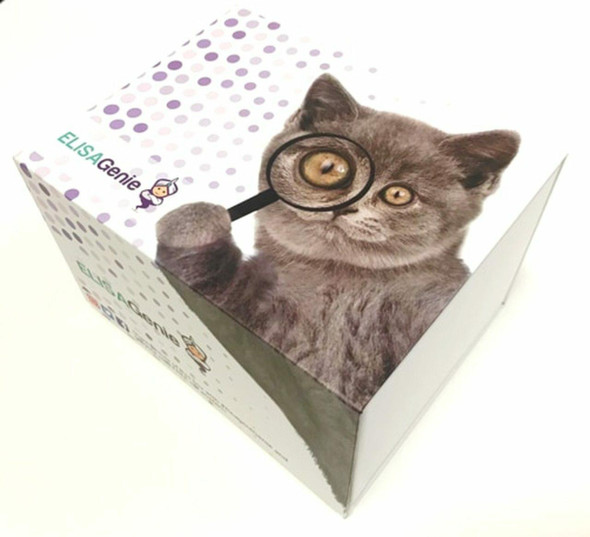Human Neuroscience ELISA Kits
Human DAT (Dopamine Transporter) CLIA Kit (HUES00701)
- SKU:
- HUES00701
- Product Type:
- ELISA Kit
- ELISA Type:
- CLIA Kit
- Size:
- 96 Assays
- Sensitivity:
- 18.75pg/mL
- Range:
- 31.25-2000pg/mL
- ELISA Type:
- Sandwich
- Reactivity:
- Human
- Sample Type:
- Serum, plasma and other biological fluids
- Research Area:
- Neuroscience
Description
| Assay type: | Sandwich |
| Format: | 96T |
| Assay time: | 4.5h |
| Reactivity: | Human |
| Detection method: | Chemiluminescence |
| Detection range: | 31.25-2000 pg/mL |
| Sensitivity: | 18.75 pg/mL |
| Sample volume: | 100µL |
| Sample type: | Serum, plasma and other biological fluids |
| Repeatability: | CV < 15% |
| Specificity: | This kit recognizes Human DAT in samples. No significant cross-reactivity or interference between Human DAT and analogues was observed. |
This kit uses Sandwich-CLIA as the method. The micro CLIA plate provided in this kit has been pre-coated with an antibody specific to Human DAT. Standards or samples are added to the appropriate micro CLIA plate wells and combined with the specific antibody. Then a biotinylated detection antibody specific for Human DAT and Avidin-Horseradish Peroxidase (HRP) conjugate are added to each micro plate well successively and incubated. Free components are washed away. The substrate solution is added to each well. Only those wells that contain Human DAT, biotinylated detection antibody and Avidin-HRP conjugate will appear fluorescence. The Relative light unit (RLU) value is measured spectrophotometrically by the Chemiluminescence immunoassay analyzer. The RLU value is positively associated with the concentration of Human DAT. The concentration of Human DAT in the samples can be calculated by comparing the RLU of the samples to the standard curve.
| UniProt Protein Function: | DAT: Amine transporter. Terminates the action of dopamine by its high affinity sodium-dependent reuptake into presynaptic terminals. Defects in SLC6A3 are the cause of dystonia-parkinsonism infantile (DYTPRI). It is a neurodegenerative disorder characterized by infantile onset of parkinsonism and dystonia. Other neurologic features include global developmental delay, bradikinesia and pyramidal tract signs. Belongs to the sodium:neurotransmitter symporter (SNF) (TC 2. A. 22) family. SLC6A3 subfamily. |
| UniProt Protein Details: | Protein type:Transporter; Transporter, SLC family; Membrane protein, multi-pass; Membrane protein, integral Chromosomal Location of Human Ortholog: 5p15. 3 Cellular Component: axon; cell soma; cell surface; cytoplasm; flotillin complex; integral to membrane; integral to plasma membrane; plasma membrane Molecular Function:dopamine binding; dopamine transmembrane transporter activity; dopamine:sodium symporter activity; drug binding; monoamine transmembrane transporter activity; protease binding; protein binding; protein complex binding; protein N-terminus binding; protein phosphatase 2A binding; receptor binding Biological Process: adenohypophysis development; aging; dopamine biosynthetic process; dopamine catabolic process; dopamine transport; dopamine uptake; lactation; locomotory behavior; monoamine transport; neurotransmitter biosynthetic process; positive regulation of multicellular organism growth; prepulse inhibition; regulation of dopamine metabolic process; response to cAMP; response to cocaine; response to drug; response to ethanol; response to iron ion; response to nicotine; sensory perception of smell; synaptic transmission; transmembrane transport Disease: Parkinsonism-dystonia, Infantile; Tobacco Addiction, Susceptibility To |
| NCBI Summary: | This gene encodes a dopamine transporter which is a member of the sodium- and chloride-dependent neurotransmitter transporter family. The 3' UTR of this gene contains a 40 bp tandem repeat, referred to as a variable number tandem repeat or VNTR, which can be present in 3 to 11 copies. Variation in the number of repeats is associated with idiopathic epilepsy, attention-deficit hyperactivity disorder, dependence on alcohol and cocaine, susceptibility to Parkinson disease and protection against nicotine dependence. [provided by RefSeq, Nov 2009] |
| UniProt Code: | Q01959 |
| NCBI GenInfo Identifier: | 7108463 |
| NCBI Gene ID: | 6531 |
| NCBI Accession: | AAC50179. 2 |
| UniProt Secondary Accession: | Q01959,Q14996, A2RUN4, |
| UniProt Related Accession: | Q01959 |
| Molecular Weight: | 68,495 Da |
| NCBI Full Name: | dopamine transporter |
| NCBI Synonym Full Names: | solute carrier family 6 (neurotransmitter transporter), member 3 |
| NCBI Official Symbol: | SLC6A3 |
| NCBI Official Synonym Symbols: | DAT; DAT1; PKDYS |
| NCBI Protein Information: | sodium-dependent dopamine transporter |
| UniProt Protein Name: | Sodium-dependent dopamine transporter |
| UniProt Synonym Protein Names: | Solute carrier family 6 member 3 |
| Protein Family: | D-alanine aminotransferase |
| UniProt Gene Name: | SLC6A3 |
| UniProt Entry Name: | SC6A3_HUMAN |
As the RLU values of the standard curve may vary according to the conditions of the actual assay performance (e. g. operator, pipetting technique, washing technique or temperature effects), the operator should establish a standard curve for each test. Typical standard curve and data is provided below for reference only.
| Concentration (pg/mL) | RLU | Average | Corrected |
| 2000 | 50417 61025 | 55721 | 55693 |
| 1000 | 23558 24390 | 23974 | 23946 |
| 500 | 12024 10040 | 11032 | 11004 |
| 250 | 5027 5561 | 5294 | 5266 |
| 125 | 2739 2477 | 2608 | 2580 |
| 62.5 | 1368 1254 | 1311 | 1283 |
| 31.25 | 667 681 | 674 | 646 |
| 0 | 27 29 | 28 | -- |
Precision
Intra-assay Precision (Precision within an assay): 3 samples with low, mid range and high level Human DAT were tested 20 times on one plate, respectively.
Inter-assay Precision (Precision between assays): 3 samples with low, mid range and high level Human DAT were tested on 3 different plates, 20 replicates in each plate.
| Intra-assay Precision | Inter-assay Precision | |||||
| Sample | 1 | 2 | 3 | 1 | 2 | 3 |
| n | 20 | 20 | 20 | 20 | 20 | 20 |
| Mean (pg/mL) | 105.61 | 311.52 | 799.85 | 104.50 | 281.06 | 863.90 |
| Standard deviation | 12.17 | 30.09 | 90.14 | 8.52 | 23.27 | 71.10 |
| C V (%) | 11.52 | 9.66 | 11.27 | 8.15 | 8.28 | 8.23 |
Recovery
The recovery of Human DAT spiked at three different levels in samples throughout the range of the assay was evaluated in various matrices.
| Sample Type | Range (%) | Average Recovery (%) |
| Serum (n=5) | 92-105 | 98 |
| EDTA plasma (n=5) | 87-98 | 92 |
| Cell culture media (n=5) | 86-98 | 93 |
Linearity
Samples were spiked with high concentrations of Human DAT and diluted with Reference Standard & Sample Diluent to produce samples with values within the range of the assay.
| Serum (n=5) | EDTA plasma (n=5) | Cell culture media (n=5) | ||
| 1:2 | Range (%) | 85-100 | 103-116 | 100-113 |
| Average (%) | 91 | 110 | 107 | |
| 1:4 | Range (%) | 103-115 | 87-100 | 94-110 |
| Average (%) | 109 | 92 | 101 | |
| 1:8 | Range (%) | 93-106 | 89-103 | 92-107 |
| Average (%) | 98 | 96 | 100 | |
| 1:16 | Range (%) | 93-106 | 88-102 | 99-112 |
| Average (%) | 100 | 95 | 106 |
An unopened kit can be stored at 4°C for 1 month. If the kit is not used within 1 month, store the items separately according to the following conditions once the kit is received.
| Item | Specifications | Storage |
| Micro CLIA Plate(Dismountable) | 8 wells ×12 strips | -20°C, 6 months |
| Reference Standard | 2 vials | |
| Concentrated Biotinylated Detection Ab (100×) | 1 vial, 120 µL | |
| Concentrated HRP Conjugate (100×) | 1 vial, 120 µL | -20°C(shading light), 6 months |
| Reference Standard & Sample Diluent | 1 vial, 20 mL | 4°C, 6 months |
| Biotinylated Detection Ab Diluent | 1 vial, 14 mL | |
| HRP Conjugate Diluent | 1 vial, 14 mL | |
| Concentrated Wash Buffer (25×) | 1 vial, 30 mL | |
| Substrate Reagent A | 1 vial, 5 mL | 4°C (shading light) |
| Substrate Reagent B | 1 vial, 5 mL | 4°C (shading light) |
| Plate Sealer | 5 pieces | |
| Product Description | 1 copy | |
| Certificate of Analysis | 1 copy |
- Set standard, test sample and control (zero) wells on the pre-coated plate and record theirpositions. It is recommended to measure each standard and sample in duplicate. Note: addall solutions to the bottom of the plate wells while avoiding contact with the well walls. Ensuresolutions do not foam when adding to the wells.
- Aliquot 100µl of standard solutions into the standard wells.
- Add 100µl of Sample / Standard dilution buffer into the control (zero) well.
- Add 100µl of properly diluted sample (serum, plasma, tissue homogenates and otherbiological fluids. ) into test sample wells.
- Cover the plate with the sealer provided in the kit and incubate for 90 min at 37°C.
- Aspirate the liquid from each well, do not wash. Immediately add 100µL of BiotinylatedDetection Ab working solution to each well. Cover the plate with a plate seal and gently mix. Incubate for 1 hour at 37°C.
- Aspirate or decant the solution from the plate and add 350µL of wash buffer to each welland incubate for 1-2 minutes at room temperature. Aspirate the solution from each well andclap the plate on absorbent filter paper to dry. Repeat this process 3 times. Note: a microplatewasher can be used in this step and other wash steps.
- Add 100µL of HRP Conjugate working solution to each well. Cover with a plate seal andincubate for 30 min at 37°C.
- Aspirate or decant the solution from each well. Repeat the wash process for five times asconducted in step 7.
- Add 100µL of Substrate mixture solution to each well. Cover with a new plate seal andincubate for no more than 5 min at 37°C. Protect the plate from light.
- Determine the RLU value of each well immediately.






